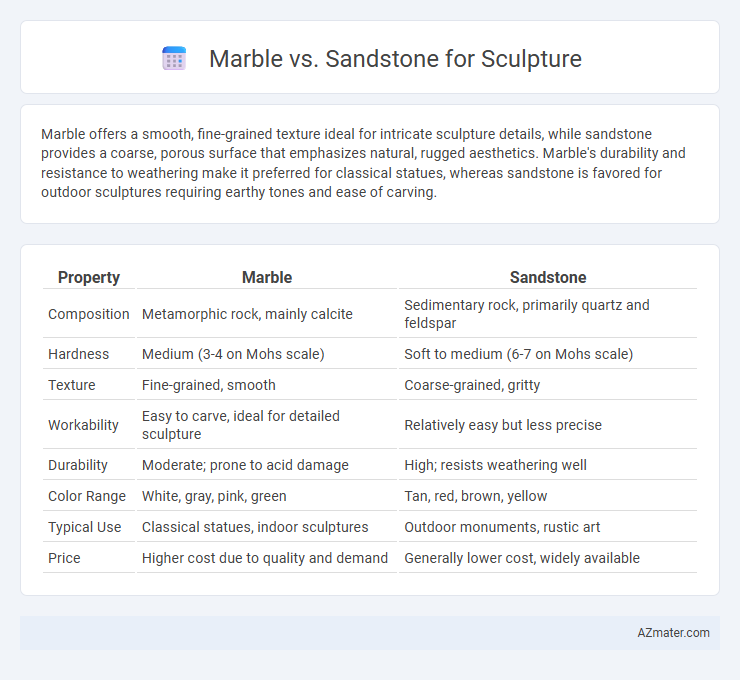Marble offers a smooth, fine-grained texture ideal for intricate sculpture details, while sandstone provides a coarse, porous surface that emphasizes natural, rugged aesthetics. Marble's durability and resistance to weathering make it preferred for classical statues, whereas sandstone is favored for outdoor sculptures requiring earthy tones and ease of carving.
Table of Comparison
| Property | Marble | Sandstone |
|---|---|---|
| Composition | Metamorphic rock, mainly calcite | Sedimentary rock, primarily quartz and feldspar |
| Hardness | Medium (3-4 on Mohs scale) | Soft to medium (6-7 on Mohs scale) |
| Texture | Fine-grained, smooth | Coarse-grained, gritty |
| Workability | Easy to carve, ideal for detailed sculpture | Relatively easy but less precise |
| Durability | Moderate; prone to acid damage | High; resists weathering well |
| Color Range | White, gray, pink, green | Tan, red, brown, yellow |
| Typical Use | Classical statues, indoor sculptures | Outdoor monuments, rustic art |
| Price | Higher cost due to quality and demand | Generally lower cost, widely available |
Introduction to Marble and Sandstone in Sculpture
Marble, a metamorphic rock composed primarily of recrystallized carbonate minerals, has been prized for centuries in sculpture due to its fine grain, durability, and ability to achieve a high polish, making it ideal for intricate detailing and lifelike textures. Sandstone, a sedimentary rock made of compacted sand grains, offers a softer and more porous surface that carves easily but lacks the smooth finish and longevity of marble in outdoor sculptures. The choice between marble and sandstone in sculpture depends on the desired aesthetic, durability requirements, and the artist's carving technique.
Historical Use of Marble vs Sandstone in Art
Marble has been the preferred material for classical sculptures due to its fine grain and ability to achieve intricate details, exemplified by Renaissance masterpieces like Michelangelo's David. Sandstone, historically significant in ancient Egyptian and Indian art, offers durability and a distinct textured appearance ideal for large architectural sculptures and reliefs. The choice between marble and sandstone often reflects regional availability and the specific artistic traditions of the period.
Physical Properties: Marble Compared to Sandstone
Marble features a fine-grained, crystalline structure that offers superior hardness and durability compared to sandstone, making it ideal for detailed and long-lasting sculptures. Its higher density and uniform texture allow for precise carving and a smooth, polished finish, while sandstone's softer, porous nature is more prone to erosion and weathering. Marble's resistance to abrasion and staining enhances its suitability for outdoor sculptures, whereas sandstone requires more maintenance to preserve its appearance over time.
Workability and Sculpting Techniques
Marble offers superior workability due to its fine grain and uniform texture, allowing sculptors to achieve intricate details and smooth finishes with chisels and rasps. Sandstone, with its coarser grain and variable hardness, requires different sculpting techniques such as point chiseling and abrasive sanding to shape and refine surfaces, making it more suitable for rough-hewn, textured sculptures. The durability and polish potential of marble contrast with sandstone's earthy texture, influencing the choice of tools and methods in the sculpting process.
Durability and Longevity of Marble and Sandstone Sculptures
Marble sculptures are renowned for their exceptional durability, resisting weathering and erosion due to their dense crystalline structure, which ensures longevity even in outdoor environments. In contrast, sandstone, composed of compressed sand grains, is more porous and susceptible to chipping and weather damage, leading to a shorter lifespan without continuous maintenance. Conservation efforts often favor marble for enduring artistic works because it maintains fine details and structural integrity over centuries, unlike sandstone which may degrade more rapidly under harsh conditions.
Aesthetic Qualities: Visual Differences
Marble exhibits a smooth, translucent surface with fine grains that create a luminous effect, enhancing the depth and detail of sculptures. Sandstone offers a more textured and earthy appearance, characterized by its granular composition and natural color variations ranging from beige to reddish hues. The choice between marble and sandstone significantly impacts the sculpture's visual appeal, with marble favored for its polished elegance and sandstone prized for its rustic, tactile charm.
Cost and Availability of Materials
Marble sculptures typically incur higher costs due to the stone's refined quality and limited quarry locations, primarily in Italy, Greece, and the USA, leading to premium pricing and selective availability. Sandstone, being more abundant globally and easier to quarry, offers a cost-effective alternative with diverse color variations, making it accessible for large-scale or budget-conscious projects. The choice between these materials hinges on budget constraints and the desired aesthetic, as marble's expense reflects its prestige and durability compared to sandstone's affordability and versatility.
Environmental Impact and Sustainability
Marble extraction requires intensive quarrying and generates significant carbon emissions and waste, impacting local ecosystems and water resources. Sandstone, often sourced from more abundant deposits with less invasive mining techniques, tends to have a lower environmental footprint and better potential for sustainable harvesting. Choosing sandstone for sculpture supports reduced environmental degradation while still offering durable material suitable for artistic expression.
Famous Sculptures: Marble vs Sandstone Case Studies
Michelangelo's David, carved from Carrara marble, exemplifies marble's fine grain and durability, making it ideal for detailed sculptures with smooth finishes. The Great Sphinx of Giza, sculpted from sandstone, showcases sandstone's accessibility and ease of carving but reveals more weathering over millennia. These famous case studies highlight marble's superiority for intricate, lasting sculptures, while sandstone offers versatility and historical significance despite its softer properties.
Choosing the Right Stone for Your Sculpture Project
Marble offers a smooth texture and fine grain ideal for intricate detail and polished finishes, making it a popular choice for classical sculptures, while sandstone provides a more natural, gritty texture suited for rustic or outdoor art that can weather environmental changes. Consider marble's higher density and durability for long-lasting indoor pieces versus sandstone's relative softness and ease of carving but lower resistance to erosion. Selecting the right stone depends on the sculpture's intended location, desired detail, and maintenance requirements, balancing aesthetic goals with practical durability.

Infographic: Marble vs Sandstone for Sculpture
 azmater.com
azmater.com